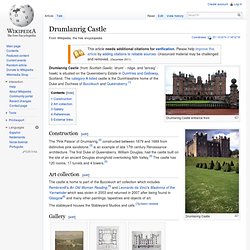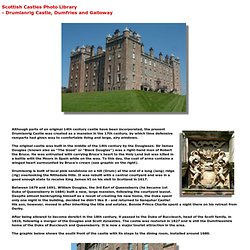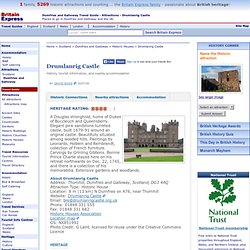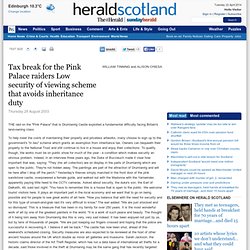

Drumlanrig Castle and Park, Thornhill (Dumfries and Galloway) - things to do in Thornhill (Dumfries and Galloway) Drumlanrig Castle. Drumlanrig Castle entrance front Drumlanrig Castle (from Scottish Gaelic: 'druim' - ridge, and 'lanraig' - hawk) is situated on the Queensberry Estate in Dumfries and Galloway, Scotland.

The category A listed castle is the Dumfriesshire home of the Duke and Duchess of Buccleuch and Queensberry.[1] Drumlanrig Castle Construction[edit] The 'Pink Palace' of Drumlanrig,[2] constructed between 1679 and 1689 from distinctive pink sandstone,[3] is an example of late 17th century Renaissance architecture. Art collection[edit] Drumlanrig Castle - Thornhill. Overview of Drumlanrig Castle. Scottish Castles Photo Library - Drumlanrig Castle, Dumfries and Galloway. Although parts of an original 14th century castle have been incorporated, the present Drumlanrig Castle was created as a mansion in the 17th century, by which time defensive ramparts had given way to comfortable living and large, airy windows.

The original castle was built in the middle of the 14th century by the Douglases. Sir James Douglas (known also as "The Good" or "Black Douglas") was a right-hand man of Robert the Bruce. He was entrusted with carrying Bruce's heart to the Holy Land but was killed in a battle with the Moors in Spain while on the way. To this day, the coat of arms contains a winged heart surmounted by Bruce's crown (see graphic on the right). Drumlanrig is built of local pink sandstone on a hill (Drum) at the end of a long (lang) ridge (rig) overlooking the Nithsdale Hills. Drumlanrig Castle and Country Estate, Dumfriesshire, South West Scotland.
Listed Building Report. Drumlanrig Castle. Drumlanrig Castle Gardens - Thornhill. Drumlanrig Castle Gardens are set on the 90,000 acre Queensberry Estate and date from the 17th century.

The gardens date back to the time of William Douglas, the 1st Duke of Queensberry, and work began on them around 1689. They extend to over 70 acres and include great formal parterres, dells, rockeries and charming summer houses as well as many impressive trees and a collection of rare shrubs from China. There is also the newly restored Victorian Greenhouse, a vegetable garden and a plant centre selling a wide range of quality plants, many of them raised in the gardens. Drumlanrig Castle. Map Data Map data ©2014 Google The magnificent Drumlanrig Castle, constructed from distinctive pink sandstone, was commissioned in 1691 by William Douglas, the first Duke of Queensberry and represents one of the first and most important Renaissance buildings in the country.

Home to the Duke and Duchess of Buccleuch and Queenbury, it is set on the spectacular 90,000 acre Queenbury Estate complete with country park, Victorian Gardens and championship Mountain BikeTrails. Drumlanrig Castle is brimming with centuries old heritage and culture, period furnishings, fine art and antiques. The gardens at Drumalanig Castle are absolutely stunning and some of the designs date back to the early 17th Century.
If you are feeling peckish during your day out, why not visit the Castle Tearoom to sample our exciting new menu featuring delicious traditional Scottish dishes served with a twist. Opening Times 2012 Gardens and Country Estate 31 March - 30 September (inclusive), daily 10 am - 5 pm Disabled Access. Go Rural - Drumlanrig Castle and Country Estate. Drumlanrig Castle. Drumlanrig Castle. A Douglas stronghold, home of Dukes of Buccleuch and Queensberry.

Elegant pink sandstone turreted castle, built 1679-91 around an original castle. Beautifully situated among wooded hills. Paintings by Leonardo, Holbein and Rembrandt, collection of French furniture. Carvings by Grinling Gibbons. Bonnie Prince Charlie stayed here on his retreat northwards on Dec. 22, 1745, and there is a collection of his memorabilia. About Drumlanrig Castle Address: Thornhill, Dumfries and Galloway, Scotland, DG3 4AQ Attraction Type: Historic House Location: 8 m (13 km) N Dumfries on A76, near Thornhill Website: Drumlanrig Castle Email: bre@drumlanrigcastle.org.uk Phone: 01848 331 555 Fax: 01848 331 682 Historic Houses Association Location map OS: NX851992 Photo Credit: G Laird, licensed for reuse under the Creative Commons Licence We've 'tagged' this attraction information to help you find related historic attractions and learn more about major time periods mentioned.
Drumlanrig Castle. Drumlanrig Castle and Burnmouth Bridge circuit. Follow the River Nith upstream along tree-lined banks from Drumlanrig Castle before heading back along a quiet, minor road with good views of the hills and surrounding countryside.

Terrain Easy paths, tracks and minor road. Some paths shared with mountain bikes and very muddy in places after wet weather. Public Transport None to start Start. DRUMLANRIG. Time Team Excavation Site Drumlanrig. Roman Empire, interesting place, historical layer / disappeared object Upload a photo Time Team get invited to all sorts of places these days, but they don’t come any grander than this.

This is Drumlanrig Castle near Dumfries in Scotland. But that’s not for us typical Time Team, what we’re interested in is something that’s been discovered round the back in the garden. There’s not much to see on the ground here, apart from a few lumps and bumps but look, this photo was taken from the air during a particularly dry summer and we see all these strange shapes and lines. The experts reckon these could be the remains of a Roman fort. Nearby cities: Newcastle upon Tyne, Darlington, Liverpool Coordinates: 55°16'13"N 3°48'15"W. Trial date for da Vinci accused. Tax break for the Pink Palace raiders Low security of viewing scheme that avoids inheritance duty. Custom byline text: WILLIAM TINNING and ALISON CHIESA THE raid on the ''Pink Palace'' that is Drumlanrig Castle exploited a fundamental difficulty facing Britain's land-owning class.

To help meet the costs of maintaining their property and priceless artworks, many choose to sign up to the government's ''in lieu'' scheme which grants an exemption from inheritance tax. Owners can bequeath their property to the National Trust and still continue to live in a house and enjoy their collections. To qualify, though, the works must be on public show for much of the year - a condition which makes security an obvious problem. Rembrandt's Storm on the Sea of Galilee Removed from a museum in Boston in 1990. Cezanne's Auvers sur Oise Taken from Ashmolean Museum, Oxford. Vermeer's Guitar Player Taken in 1974 by IRA sympathisers. The Duke of Buccleuch. Princess Alice: no Victorian, but eminent none the less.